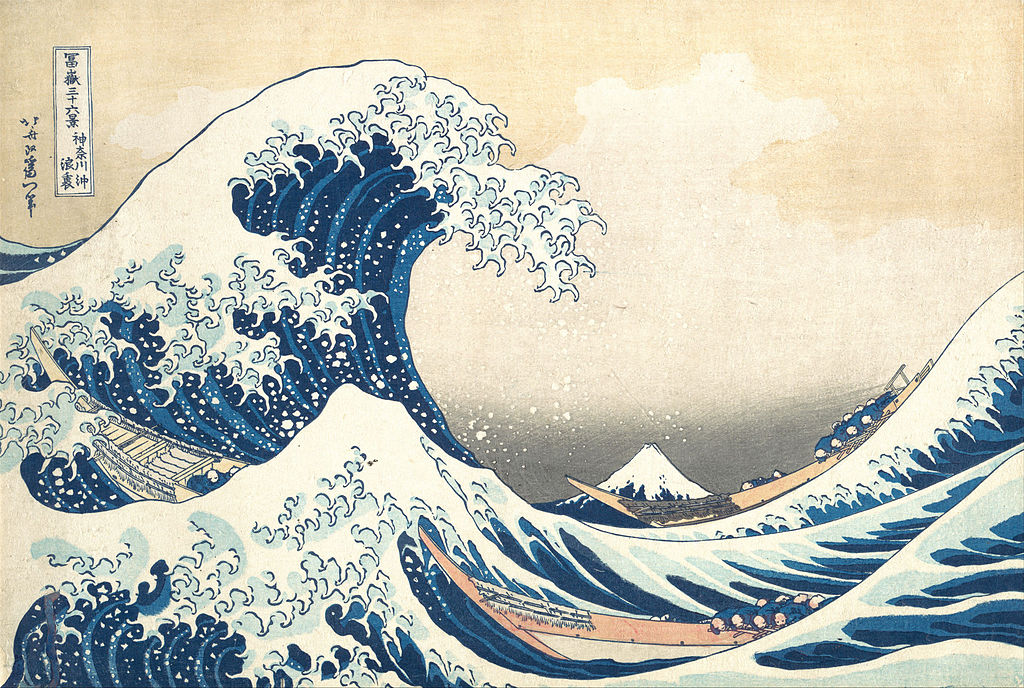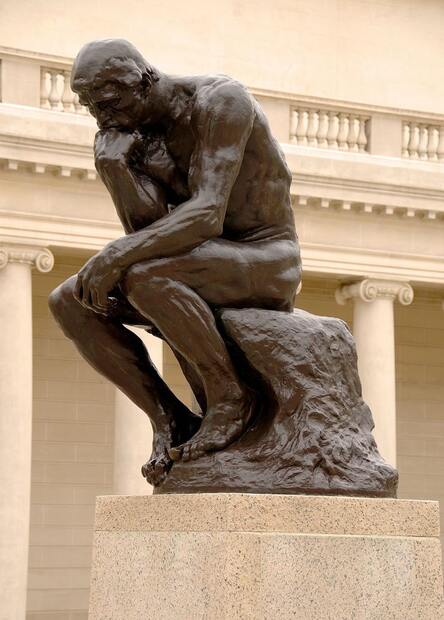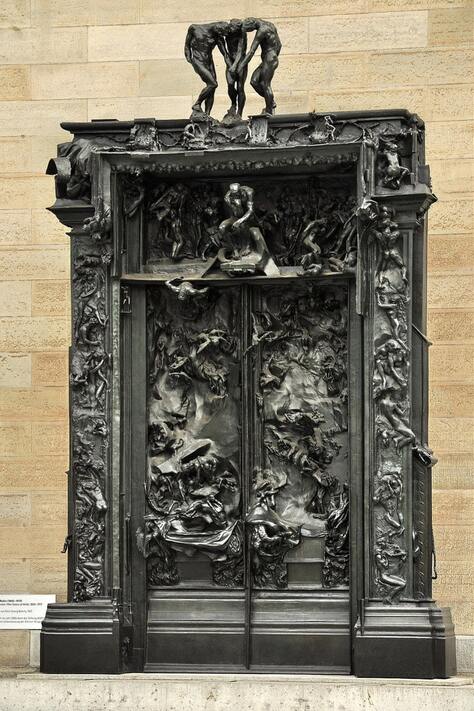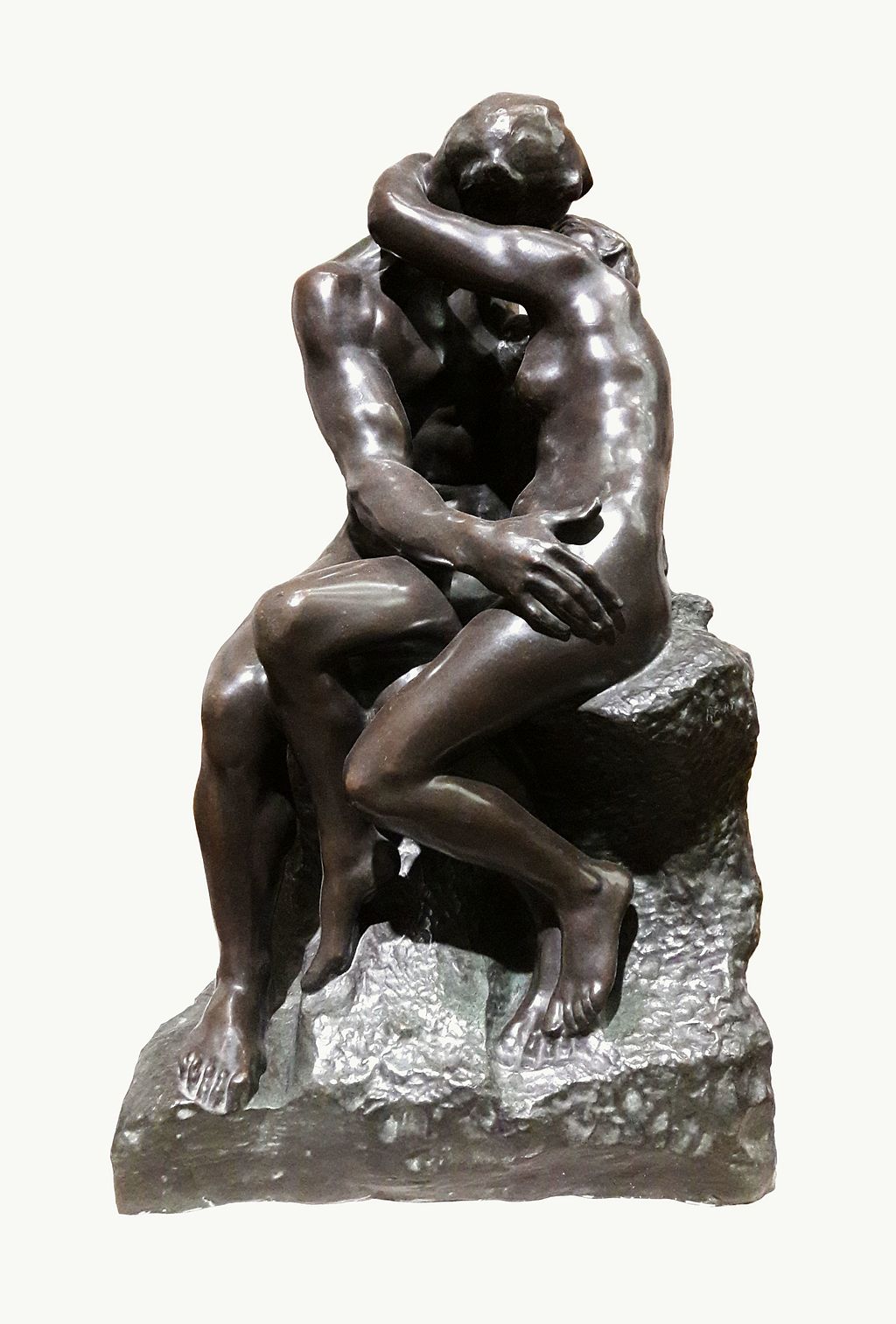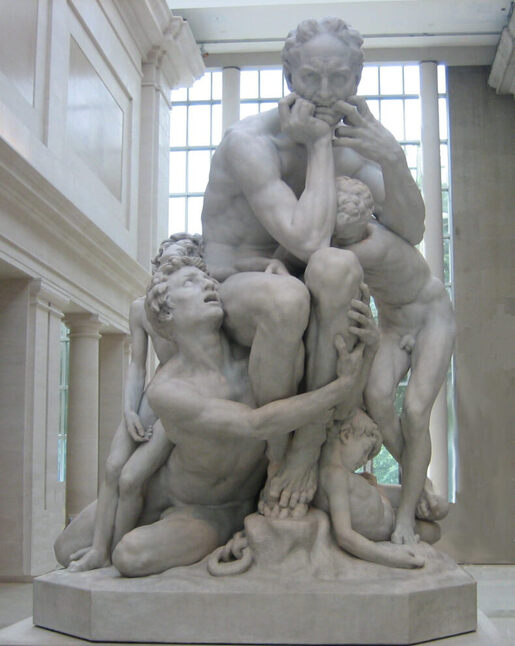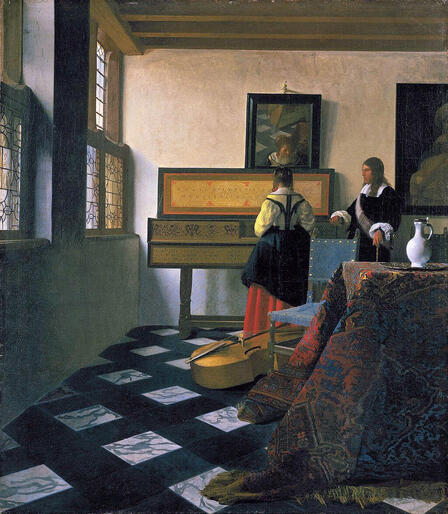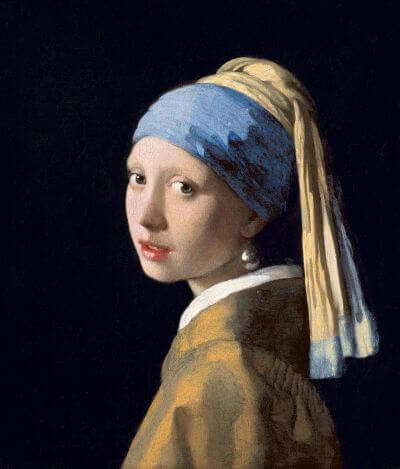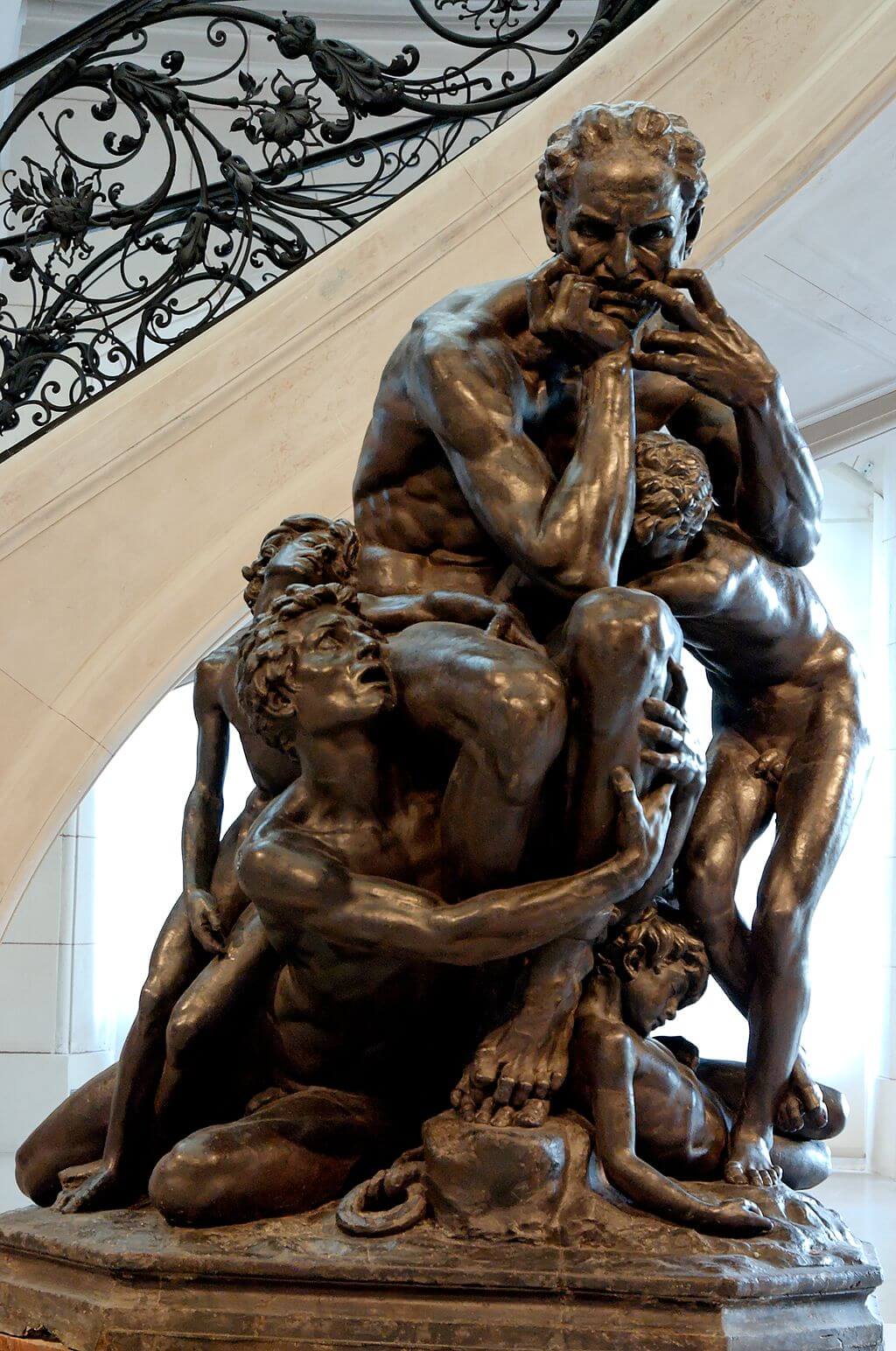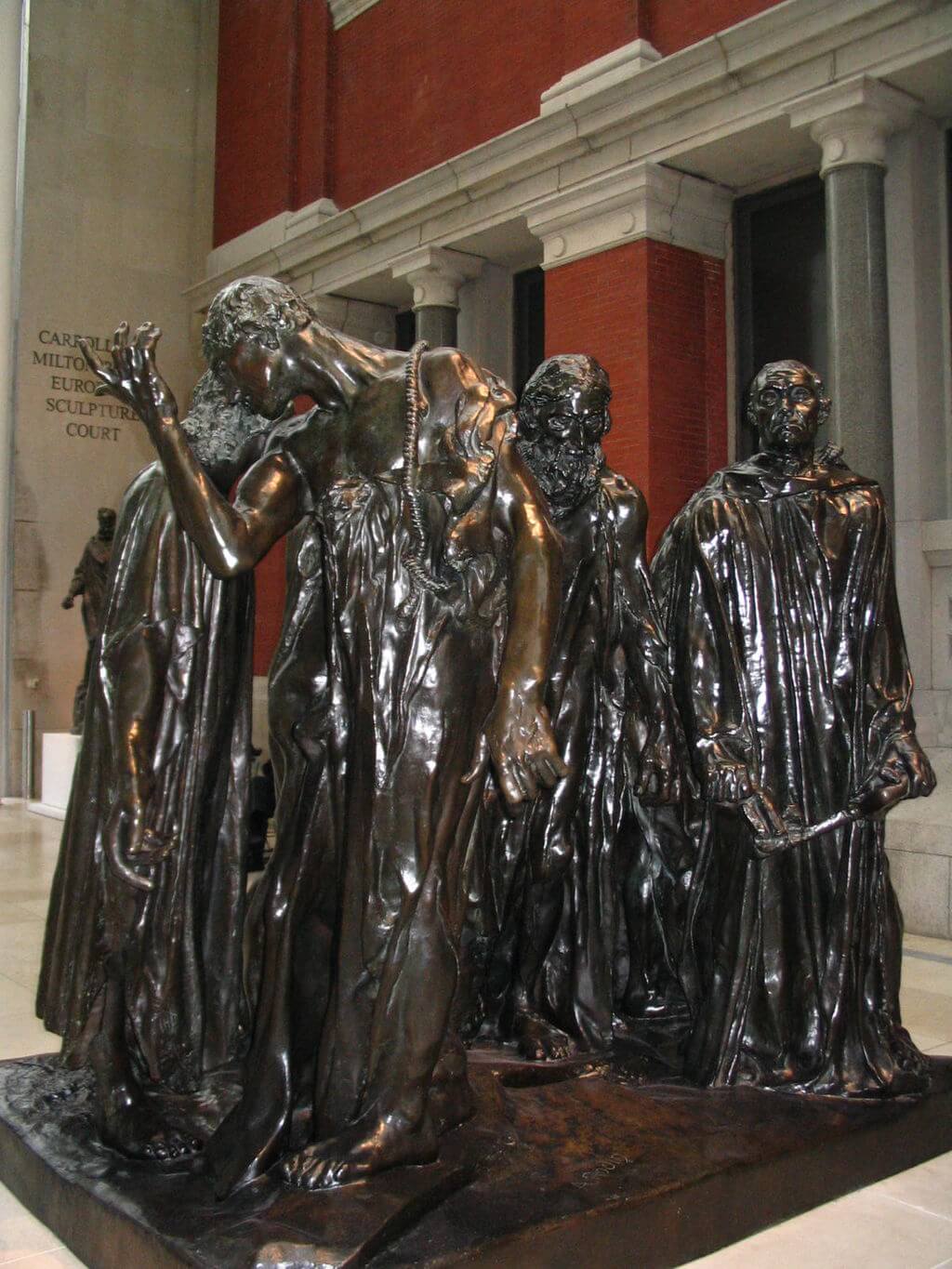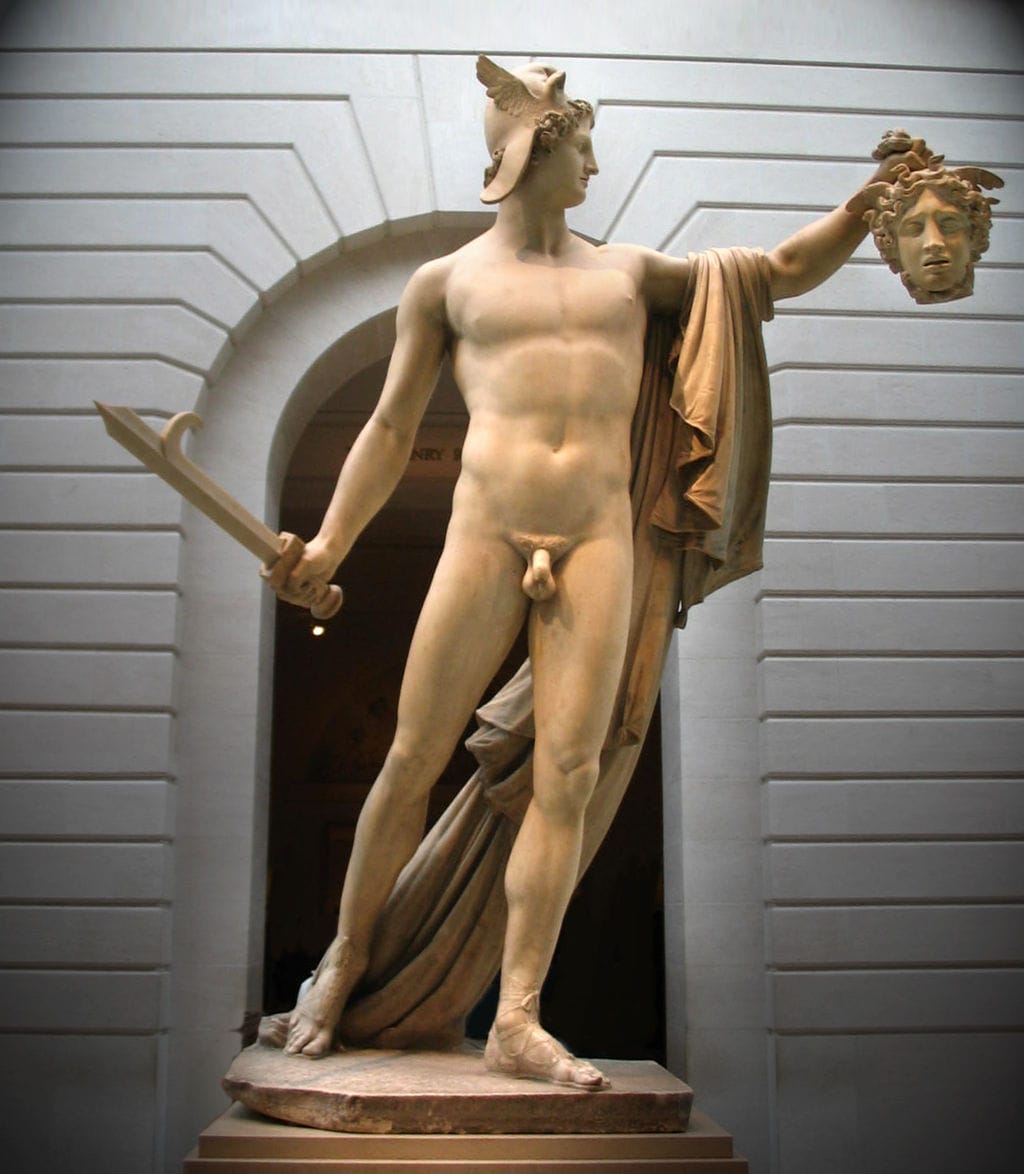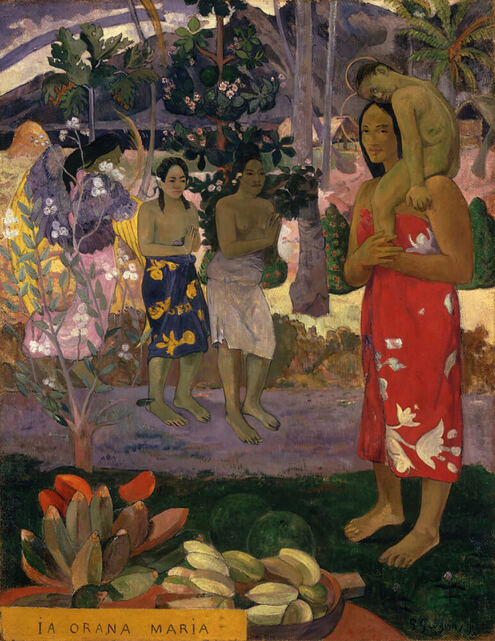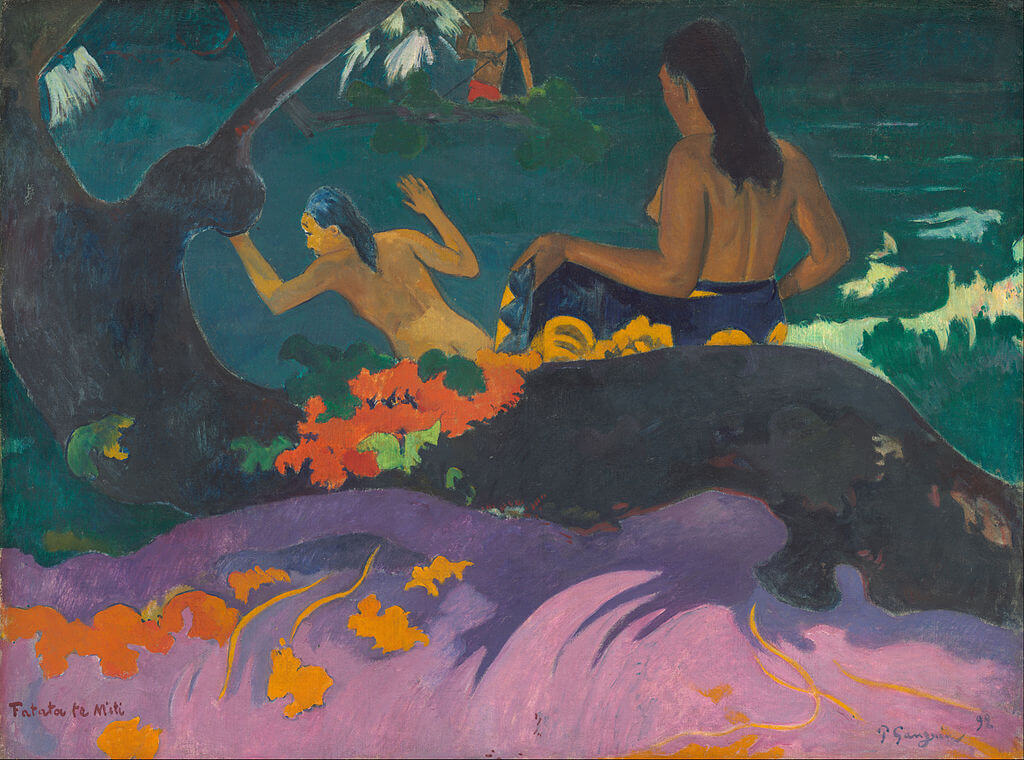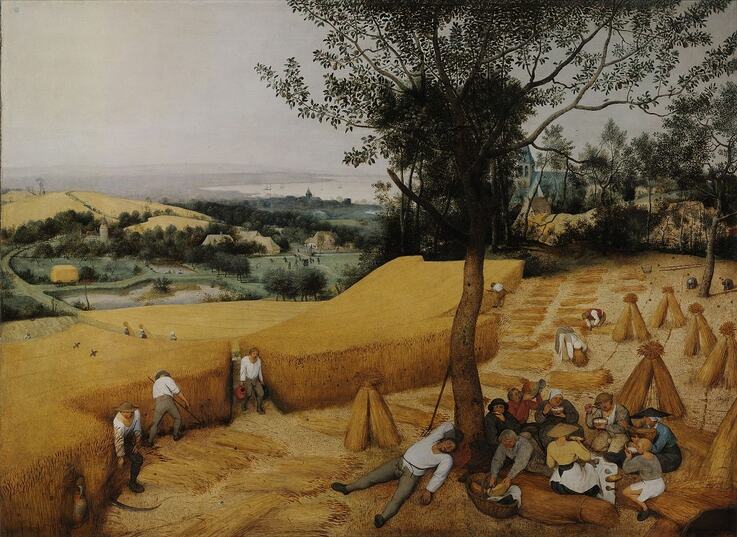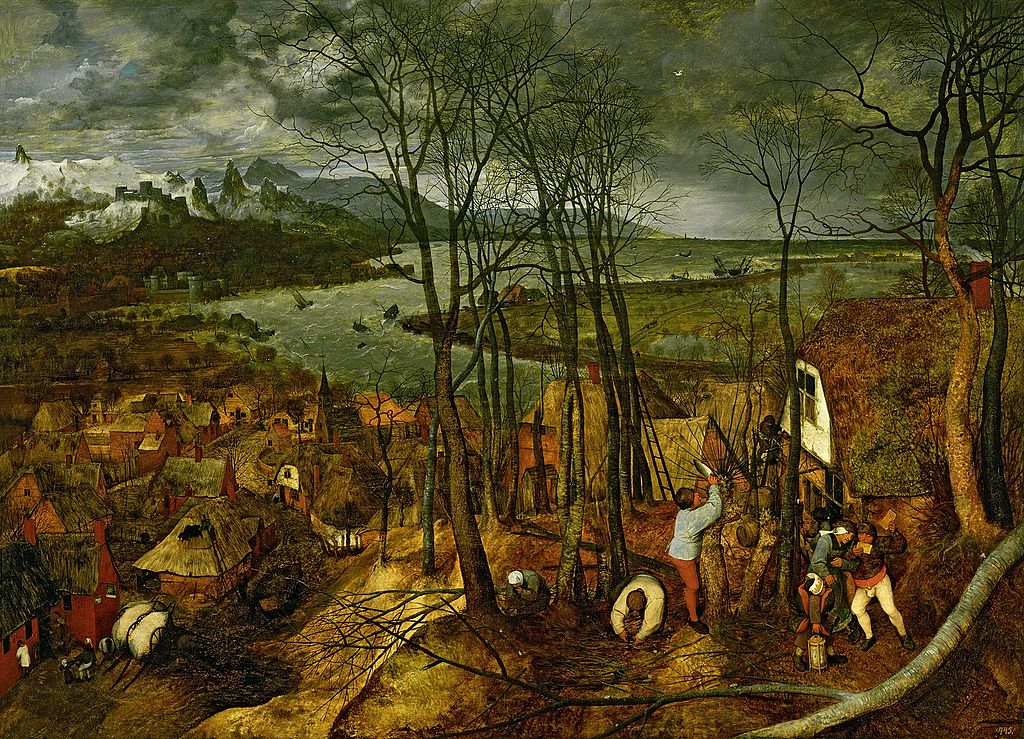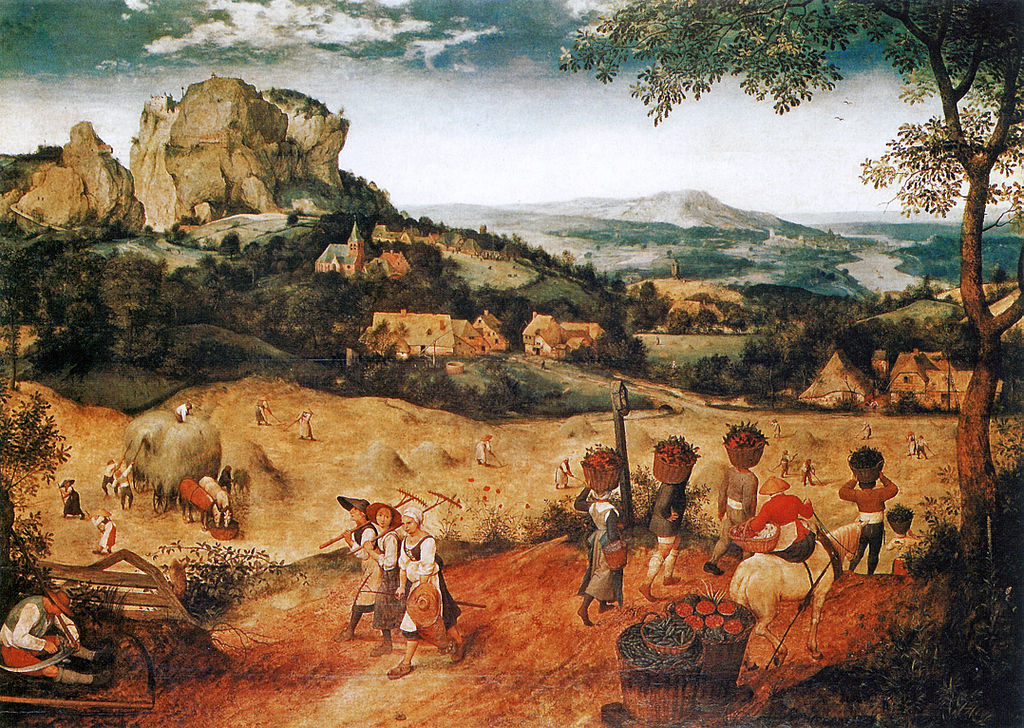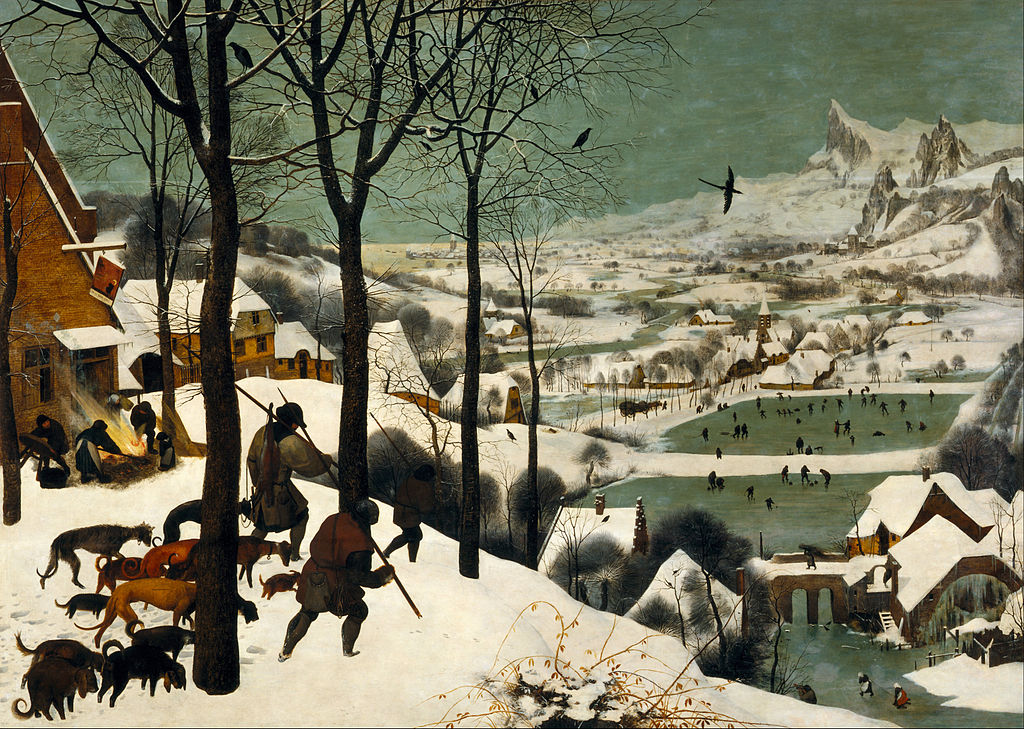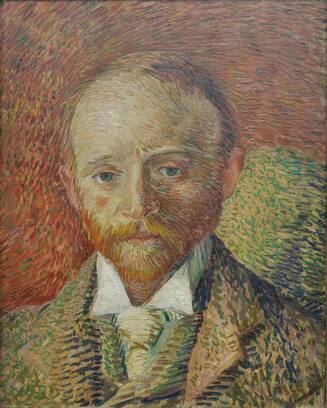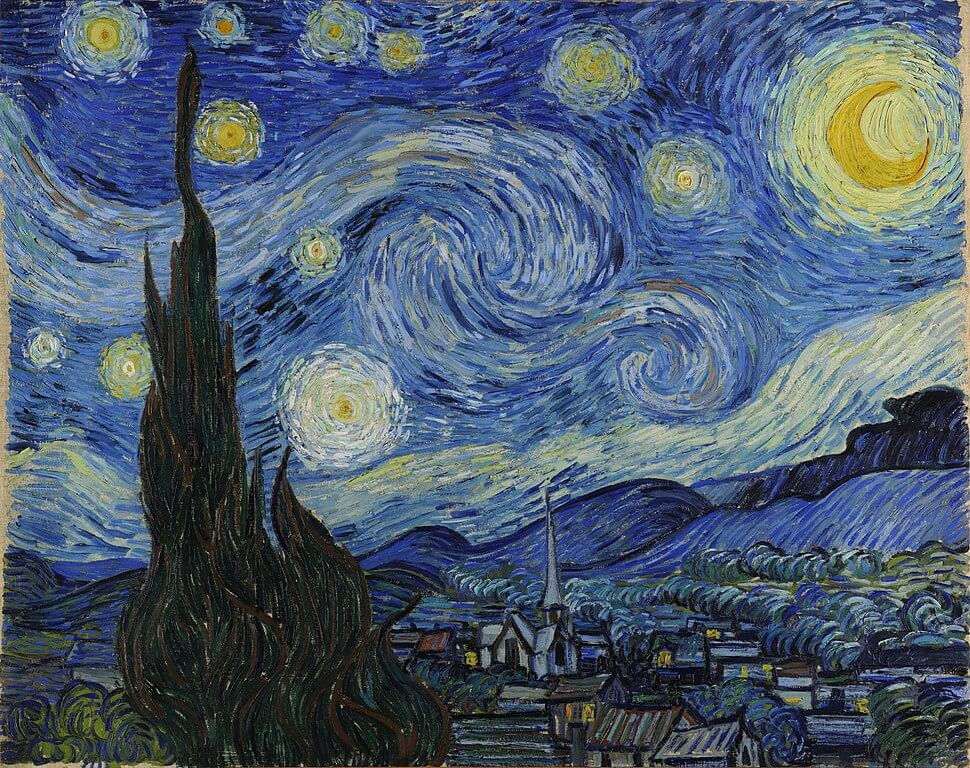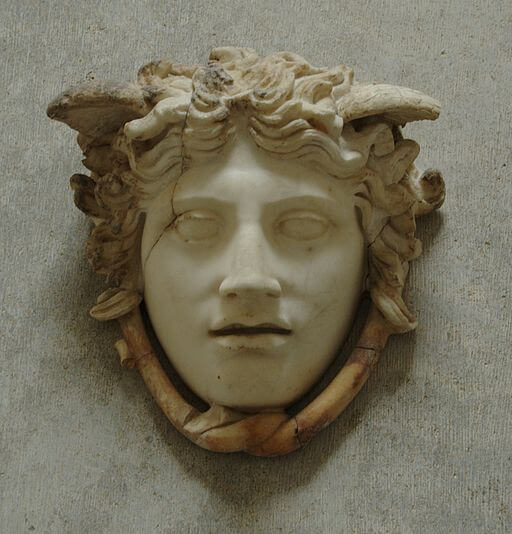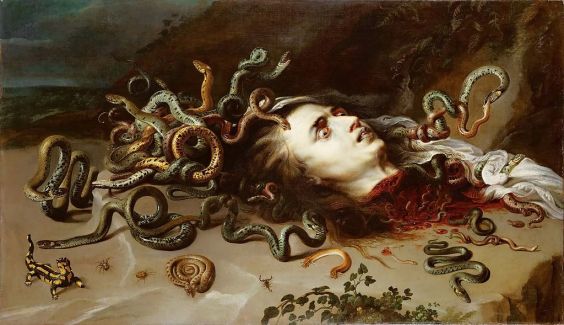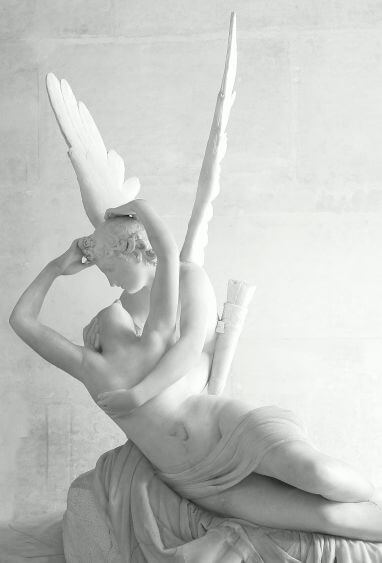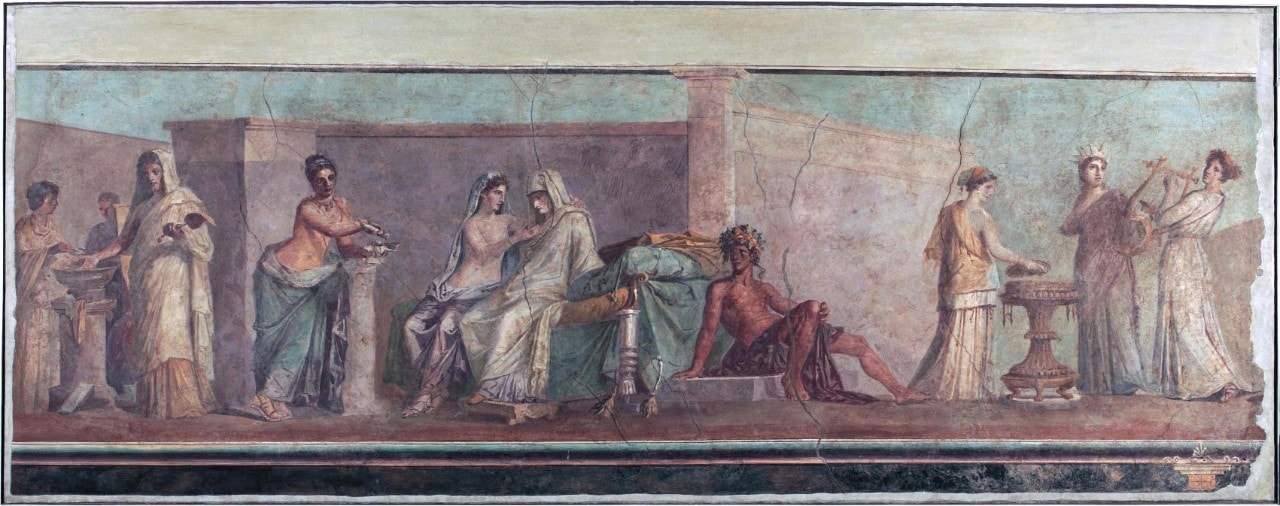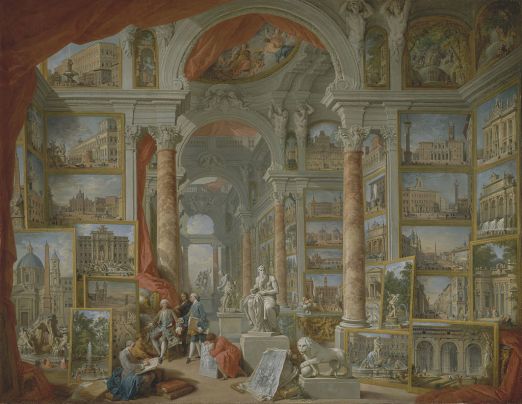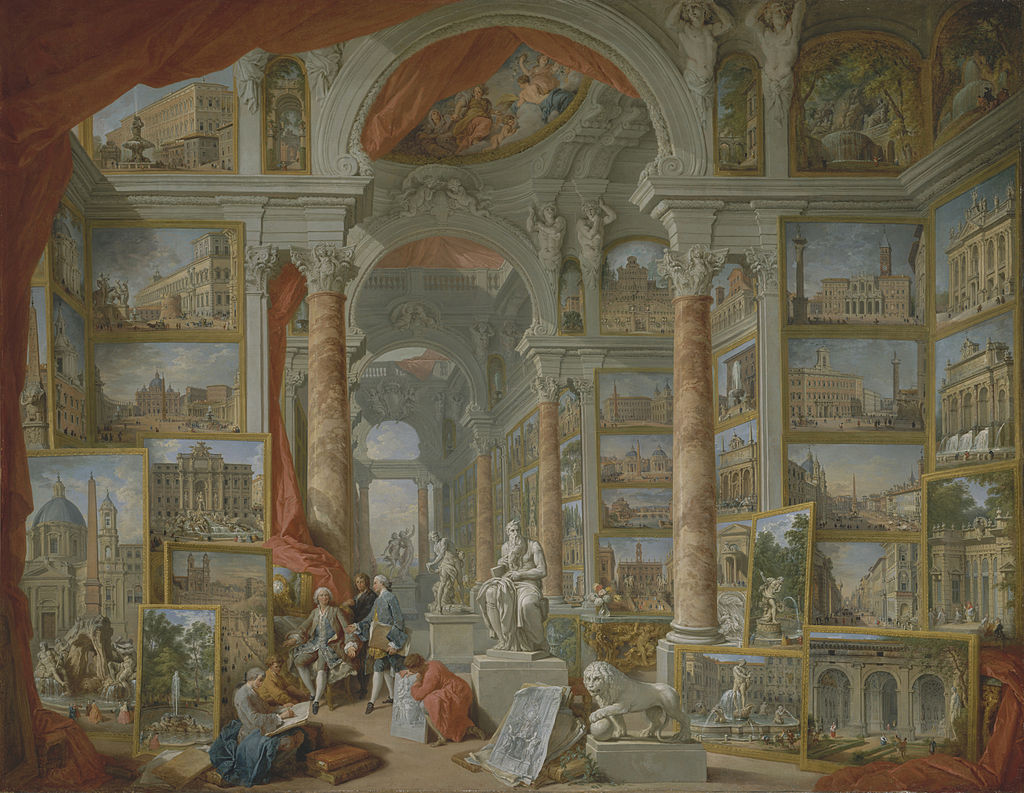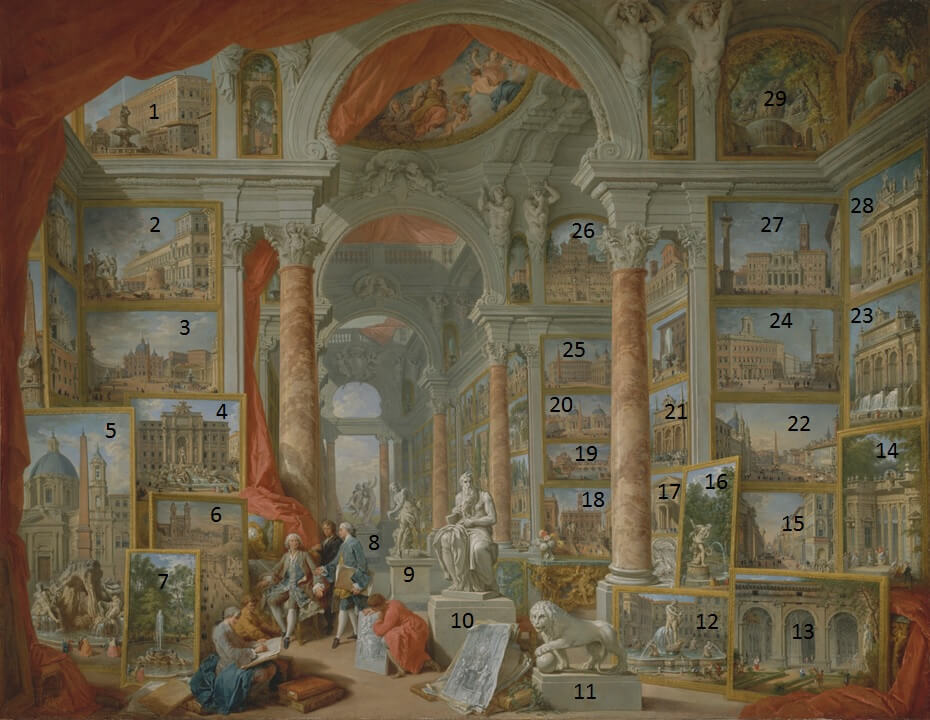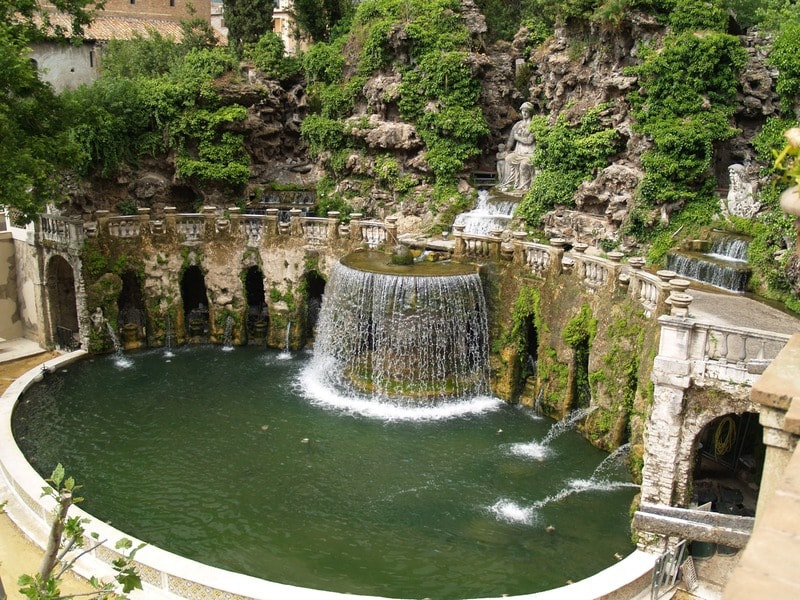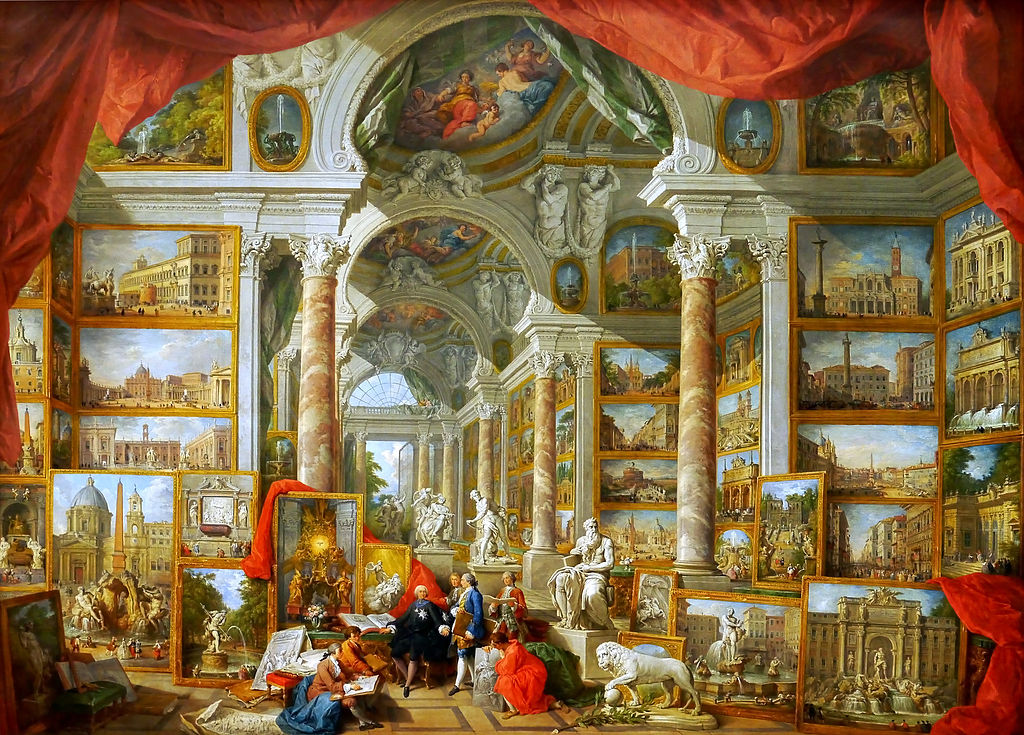|
Where? Many museums own a woodblock print of this work, including the Art Institute of Chicago, British Museum, Metropolitan Museum of Art, and the Museum of Fine Arts in Boston, but this work is usually not on permanent display.
When? 1829-1832 What do you see? A giant wave off the shore of the Kanagawa prefecture dwarves three boats — one in the foreground, one in the middle ground, and one in the background. The perfect curves of the wave’s form the relentless rocking feeling that terrifies the occupants and rowers on the tiny boats. Perhaps they are fishermen. Above them, it’s raining seafoam, represented with delicate white specks and claw-like crests. In the distance, standing before a grey haze is Japan’s great Mount Fuji. The mountain balances the downward curve of the wave while emphasizing the enormousness of the wave. Backstory: Hokusai created The Great Wave as part of a series of landscapes titled Thirty-Six Views of Mount Fuji (Fugaku sanjurokkei). Mount Fuji, a sacred spiritual site in Japanese culture, appears in every print in the series, but is not conspicuous in every piece. Often, it appears in the background of the prints such as in the case of The Great Wave off Kanagawa. The scenes that Hokusai created surrounding Mount Fuji were drastically different, varying in season, setting, and overall atmosphere. There are serene scenes such as Inume Pass in the Kai Province, lonesome scenes such as Tama River in Musashi Province, and intense scenes like The Great Wave. Showing the important landmark from several locations, Hokusai emphasized the permanence and stillness of Mount Fuji. No matter the condition of life, the mountain would remain exactly where it stands.
Ukiyo-e: Ukiyo-e, meaning “pictures of the floating world,” was the major art style of the Edo period, which was popular between 1603 and 1868 in Japan. During this time, under the rule of the Tokugawa shogunate, ideas like sensuality and tranquility were promoted, prompting the creation of a genre of art depicting leisurely daily life.
Ukiyo-e began on silk screens depicting life in the urban sphere. The genre blew up when ukiyo-e artists began creating woodblock prints. The medium allowed for mass production and mass consumption. These images of courtesans, kabuki, daily activity, and nature soon spread to Europe once Japan opened its ports in 1853 spurring the Impressionist movement and inspiring artists such as Van Gogh, Gauguin, and Toulouse-Lautrec. Who is Hokusai? Katsushika Hokusai was a prominent printmaker and painter of the Edo period. He was born in 1760 and died in 1849 after a long career of art making. When he was 19 years old, he studied under Katsukawa Shunsho who gave him the skills to begin producing his own unique artworks when he was 20. After a dispute with his teacher, Hokusai ended his studies and began making sketches for woodblock prints that would be turned into picture calendars alongside his own prints of portraits of women. Soon he became a major player in the ukiyo-e movement, competing with Hiroshige and creating illustrations and paintings for popular fiction books. A practicing Buddhist, Hokusai paid special attention to nature, and, in his own time, he produced many landscape paintings and prints including Thirty-Six Views of Mt Fuji in which his unique style became more prominent. He also painted birds and flowers with bright, intense colors. Hokusai was careful to depict daily life without any exaggerations but with great beauty. Towards the end of his life, Hokusai grew weak in both his health and skill. Nonetheless, before his death at the age of 89, Hokusai created numerous works depicting mystical images such as demons and dragons, a change of pace from his typically realist style. Fun fact: French composer Claude Debussy is said to have been influenced by Hokusai. When Japan opened its ports in 1853, the japonisme movement took over Europe. People quickly got their hands on Japanese goods like furniture and artwork that they would use to decorate their homes. As a student in Rome, Debussy frequently purchased Japanese goods. One of the prints that he discovered and hung on the walls of his home in Paris was The Great Wave which is said to have inspired his masterpiece, La Mer.
0 Comments
Where?
When? Rodin created the original sculpture in 1881. He created the first monumental-size sculpture in 1903 and after this many casts of the sculpture have been created, even after his death in 1917. What do you see? A sculpture of a muscular, naked man sitting on a rock. The man is in deep thought and uses his whole body to think. His head is bent forward and leans on his right hand. His wrinkled face, knitted eyebrows, swollen nostrils, compressed lips, and absent-minded gaze reinforce the idea that the man is deep in his thoughts and is completely unaware of the world around him. The man is struggling with his thoughts with every part of his body. Almost no part of his body is relaxed. Most muscles are tense, which is clear by looking at the clenched fist, the arched back, the legs below his body, and the squeezed toes. The statue is over six feet tall making the figure larger than life. It was the intention of Rodin to put the independent sculpture on top of a pedestal such that it would make a colossal impression on the viewers. Backstory: In 1880, Rodin received a large commission from the Directorate of Fine Arts in France to create the entrance doors for a new museum that was to be built (but never opened in the end). He was given the freedom to choose his own theme and decided on creating a scene from Dante’s book Inferno. Rodin was supposed to finish the project in five years but continued to work on the project for 37 years until his death in 1917. The doors – named The Gates of Hell – would eventually include a total of 180 different figures, and they would form the basis for many of Rodin’s most famous statues. Rodin originally created all figures in plaster, and the doors were then to be cast in bronze. The central and the most important part Rodin created for these doors was the statue of The Thinker (Le Penseur in French) who sits right above the two doors with all the characters from the Inferno behind him. The statue was about 27 inches (70 cm) high.
Multiple versions: The statue of The Thinker can be found all around the world. Rodin created the first version of this statue in plaster in 1881. In 1903, he completed the first monumental-size version of this statue. He considered it to be a remarkable piece and wrote to the client of his first bronze casting that he would ensure that only a few copies of the statue would ever be made. However, he did not keep his word.
During Rodin’s life, already more than 20 versions of The Thinker were produced. And after his death, the right for reproduction was turned over to the Republic of France. Nowadays, more than 70 bronze and plaster versions exist and are on display in Asia, Australia, Europe, North America, and South America. Interpretation: There are various interpretations of what and who The Thinker represents. When initially creating this statue as part of The Gates of Hell, Rodin meant the figure to represent Dante pondering about the fate of the damned people entering through the Gates of Hell. This interpretation is based on Dante’s book Inferno, the first part of his trilogy known as The Divine Comedy. When Rodin started to create independent versions, he started to consider different interpretations. Overall, he considered the statue to represent the struggle of the human mind. But he also started to see hope in it. The thoughts slowly become clear, and the man turns from a thinker, into a dreamer, and finally into a creator. Over time, other interpretations have also been given. Some consider the statue to represent Rodin himself. Others interpret the figure as Adam contemplating the sin he committed in Paradise. Who is Rodin? François Auguste René Rodin was born in 1840 in Paris, where he died 77 years later in 1917. He was rejected three times by the leading art school in Paris, the École des Beaux-Arts. It forced him to educate himself differently and this has contributed to his unique style. He was inspired by some of the great Renaissance sculptors like Donatello and Michelangelo. Most of Rodin's famous sculptures were originally intended for his commission of The Gates of Hell. Over time, he realized that he could turn many elements of The Gates of Hell into separate statues and some of these statues have achieved world fame. Among them are The Three Shades and The Kiss. Many of Rodin’s statues have been cast multiple times in bronze which means that his statues have spread across the world.
Why a bronze statue? Bronze is a combination of different metals. It consists primarily of copper (typically 85-90%) and tin (typically 10-15%), but can also contain minor quantities of other metals or nonmetals. It is an attractive material for sculptors for the following reasons.
Fun fact: While The Thinker is one of the most famous statues in the world, Rodin initially named this statue “the poet.” Later it was renamed based on suggestions by foundry workers that the sculpture was quite similar to a sculpture by Michelangelo on Lorenzo de’ Medici, Duke of Urbino. This sculpture was more popularly known as “Il Penseroso” (The Thinker), and this name was also given to Rodin’s statue. The Thinker also shows some resemblance to Ugolino and His Sons which was created by Jean-Baptiste Carpeaux in the 1860s.
Where? Gallery 632 of the Metropolitan Museum of Art
When? Around 1662 What do you see? A young woman opens a leaded window with her right hand, and she holds a water pitcher in her left hand. She wears a blue dress with a blue and gold-like vest (called a bodice) on top of it. She also wears a white collar and an equally white linen head covering. The silver water pitcher is standing on a silver basin. The table is covered with an expensive and colorful tablecloth with flower patterns. On the right of the table is a box with a blue ribbon and a pearl necklace. Behind the table is a chair with a carved lion on top of it. A blue cloth hangs over the chair. On the top right hangs a map of the seventeen provinces of Hapsburg Netherlands in the 17th century (interestingly, the west of Hapsburg Netherlands is shown on the top, and the north is shown on the right). The walls in this room are somewhat off-white (which is clear when seen in contrast to the head cover of the woman) and we can see the effects of the sunlight. We can recognize different shadows on the wall left of the woman, but we can, for example, also observe the shadows on the nails in the chair. The light in this painting is gently changing the colors of the various objects. It is not entirely clear what the woman is doing. It is possible that she wants to water some of the flowers that are outside the window or she may want to clean the window. Note that the window is the same as the left window in The Music Lesson by Vermeer.
Backstory: This painting is also known as Woman with a Water Jug. It is a genre painting depicting an everyday scene from the life of the 17th-century middle class in The Netherlands.
In 1887, Henry Marquand acquired this painting for $800 and later donated it to the Metropolitan Museum of Art. This was the first Vermeer painting to come to the United States. Balance and peacefulness: As in many other paintings of Vermeer, this painting shows a balanced composition which results in a very peaceful domestic scene. First, Vermeer achieves this by using a limited number of colors in this painting. He mainly uses the three primary colors: blue, red, and yellow. Second, Vermeer took many months to complete a single painting, and he added and removed various elements over that period to create the harmony that we see in this final version. For example, based on infrared technology, we know that Vermeer originally included another chair in the left foreground and the map on the wall was bigger and placed much more to the left. However, this created a more chaotic scene, and Vermeer proceeded to update the painting (check here for a virtual reconstruction of the earlier version of this painting). While removing the chair may not have been that much work, completely redoing the map on the wall on a different location was a lot of work and explains why Vermeer took such a long time to complete a painting (and the map turns out to be very accurate). Who is Vermeer? Johannes Vermeer was born in Delft, The Netherlands, in 1631 and died there in 1675. His father owned a tavern and was an art dealer. Early in his career, Vermeer got some inspiration from works by the followers of Caravaggio and especially their use of light. Vermeer developed his own style and primarily focused on genre paintings. The domestic scenes that he portrayed have become famous through their realism and excellent use of light and shadow. Besides the current painting, other examples that illustrate his brilliance are The Milkmaid in the Rijksmuseum in Amsterdam and Girl with a Pearl Earring in the Mauritshuis in The Hague. The work of Vermeer was certainly appreciated during his career, but after his death, there was a period of almost two hundred years during which his work was largely forgotten or attributed to other better-known painters. In the second half of the 19th century, his work was rediscovered and quite some well-known paintings were attributed to Vermeer.
Fun fact: As you can see in the paintings above, Vermeer used a lot of blue in his paintings. For this he used the pigment ultramarine (which is a natural pigment made from lapis lazuli). The use of this pigment differentiated him from his contemporaries as lapis lazuli was very expensive.
Most other painters used the much cheaper azurite to create blue. Lapis Lazuli is a rock with a deep blue color, and this rock was not available in Europe but had to come from countries like Afghanistan. Ultramarine is created by grinding lapis lazuli into powder and combining it with a drying oil. Titian is another well-known artist who often used ultramarine. During the Renaissance, ultramarine was primarily used to paint the robe of the Virgin Mary. The ultramarine pigment remained very expensive until 1826 when synthetic varieties of ultramarine became available. Interested in a copy for yourself? Poster
Where?
What do you see? Ugolino is sentenced to starve to death together with his children. This sculpture shows the moment that Ugolino considers cannibalism. He is depicted together with his four children, all naked, but is ignoring his children in this sculpture. He looks desperately in the distance and is biting his fingers and pulls his lip down with them. He holds his head in the palm of his hand. He is contemplating the consequences of his sins. He is sculpted as a muscular man even though he is starving to death. He is bending forward and has his feet on top of each other. The four children are in different states of suffering, and they beg their father to eat them such that he can stay alive. The oldest boy seems most energetic. He has his fingers in the flesh of Ugolino’s leg to emphasize his begging. The second oldest son on the right is also holding his father with both hands. The second youngest son on the left sits on top of his oldest brother and has already lost most of his remaining energy. He has his left arm on his father’s leg. The youngest son is on the bottom right and while he is the only one with a peaceful expression he appears already dead. Carpeaux is telling a story with this sculpture, something that is very difficult to do in a sculpture. He was able to sculpt the skin, muscles, and veins very realistically and to express the strong emotions of the different subjects. The more you look at the details of this marble statue, the more "alive" the subjects become. For example, you can see Ugolino’s agony by the curve in his spine, and even the toes of Ugolino are curled to show his agony. Different versions of this statue: Several sculptures of Ugolino and His Sons have been made. Carpeaux got the idea of creating a sculpture of Ugolino and his sons in 1858. He started by making a plaster version of it, which he completed in 1861. This version is in the Petit Palais in Paris. After that, in 1862, he created a bronze version which is now in the Musée d’Orsay. The final version he created was the marble version in the Metropolitan Museum of Art. Rodin was inspired by the sculptures of Carpeaux and, in 1881, he made a plaster version of Ugolino and His Children which is in the Musée Rodin in Paris.
Backstory: This work is created under the supervision of Carpeaux and is based on canto 33 of Dante’s Inferno (which is the first part of the Divine Comedy). In this book, Dante travels through the nine circles of hell. Each circle contains people who are convicted in hell for a different sin. In the ninth circle, he meets Count Ugolino della Gherardesca (c. 1220-1289), who was convicted for treachery. In 1288, Ugolino worked together with the archbishop Ruggieri to take control of the factions in Pisa. However, in this process, Ruggieri betrayed him and locked Ugolino up in prison.
More precisely, Ugolino was imprisoned together with his children and grandchildren in a tower and condemned to starve to death. His children begged Ugolino to eat them to survive, and his hunger was stronger than his sadness about his dying children. It is unclear whether Ugolino ate his children in the end. In Dante’s story, Ugolino’s eternal punishment in hell is that he is stuck up to his head in the icy waste of Antenora which is the punishment for political traitors. Meanwhile, he is chewing the head of Ruggieri (the person who betrayed him in real life) who is also stuck in the ice. Who is Carpeaux? Jean-Baptiste Carpeaux (1827-1875) was born in Valenciennes, France and died in Paris. In 1854, he moved to Rome, where he got inspired by the Renaissance artists such as Donatello, Michelangelo, and Del Verrocchio. Carpeaux suffered a lot during his life, both mentally and physically, and you can see that back in some of his extreme works. His sculptures are known for the emotions they evoked among the viewers, and he distinguished himself with his style from his contemporary colleagues. He is considered one of the greatest sculptors of his time, though most people consider Antonio Canova (who was born before him) and Auguste Rodin (who was born after him) to be even better. Fun fact: The sculpture in the Metropolitan Museum of Art is placed very close to the entrance of the Petrie Court Café. It is ironic that this sculpture with the theme of starvation is so close to the Café. While this may be a coincidence in itself, another statue that deals with starvation is also close to the Café. Rodin’s bronze The Burghers of Calais sculpture shows six leaders of the city of Calais who are starving and have a rope around their neck as they will be executed soon. The marble statue of Carpeaux is also next to the statue of Perseus with the Head of Medusa by Antonio Canova.
Where? Gallery 825 of the Metropolitan Museum of Art
When? 1891 What do you see? This painting contains five people. On the right is Mary with her naked child Jesus sitting in an odd pose on her shoulder. Both have a halo around their head and are looking at the viewer. Mary is wearing a red pareo (which is a dress that is wrapped around the middle or higher and is typical for people in Tahiti and the Cook Islands) wrapped around her with a hibiscus flower motif on it. On the left, you can see a female angel (probably representing the Archangel Gabriel) dressed in pink and with blue and yellow wings. The angel is partly hidden behind a flowering tree. The angel points out the presence of Mary and Jesus to the two Tahitian women on the purple path. These two women are dressed in a pareo from the waist down, and they fold their hands in devotion. In the foreground is a collection of fruit laying on a fata, which is a wooden altar that Polynesians use to make offers to their gods. These fruits may be an analogy to the gifts that the three Magi brought to Jesus after his birth. The fruit includes red and yellow Tahitian bananas (some of which are in a wooden bowl) and the green breadfruit in the center. In the background, you can see the dark mountains, a lake, palm trees, and flowering bushes. There is a boathouse on the right side of the lake.
What is Hail Mary? Also known as the Angelic Salutation or Ave Maria, Hail Mary is a prayer in the Catholic Church. The full text of this prayer is:
“Hail Mary, full of grace, the Lord is with thee. Blessed art thou amongst women and blessed is the fruit of thy womb, Jesus. Holy Mary, Mother of God, pray for us sinners, now, and in the hour of our death. Amen.” This prayer is the most popular prayer aimed at Mary and asks for her help in intervening between the person praying and God. Who is Gauguin? Eugène Henri Paul Gauguin (1848-1903) is a Post-Impressionist artist who is known for his experimental use of colors. Vincent van Gogh and Edgar Degas were important for Gauguin in developing his unique style. In 1891, Gauguin moved to Tahiti to start a new life. His idea was to set up a community of painters, called l’atelier des tropiques in an area that was far away from home and did not suffer from the materialism that was present in France. The main idea behind this initiative was to stimulate the role of spirituality in their artworks and to expose themselves to different cultures and religions. In the end, no other painters joined him, and he left alone to Tahiti. However, this did not have a negative effect on the quality of Gauguin’s work, and he produced some of his best works during this period, including By the Sea (Fatata te Miti) in the National Gallery of Art and Spirit of the Dead Watching (Manao Tupapau) in the Albright–Knox Art Gallery in Buffalo. Most of Gauguin’s paintings are based on his imagination, and he expressed in a letter to his wife that he believed that his artistic center was in his mind and did not need to be inspired by other painters.
Fun fact: Gauguin did not have any models from Tahiti in front of him to paint this picture, but rather painted this based on his imagination and some other stimuli that he brought to Tahiti. For example, as Tahitians were not walking around half-naked, the two women in the middle are modeled after the figures of dancers on a bas-relief of the Javanese Borobudur temple of which he had brought a picture. Also, the pose of Jesus on top of Mary’s shoulder was based on a postcard that Gauguin bought during his trip to Tahiti. Moreover, Gauguin was one of the first artists to depict Mary and Jesus with a colored skin, something that was not allowed yet by the Catholic Church.
Where? Room 642 of the Metropolitan Museum of Art
When? 1565 Commissioned by? Niclaes Jongelinck, a Belgian art collector and banker. What do you see? This painting depicts the late summer harvest in Belgium. Imagine yourself standing on top of the hill in the foreground observing and listening to this 16th-century agricultural scene. Against a background of low hills and a valley, you can see more than 40 people in this painting engaged in various activities (the longer you look at this painting, the more people you discover). In the right foreground, next to the large pear tree (you can see the pears hanging in the tree), a group of hungry people is eating and drinking. They are consuming bowls with milk and cereals, pears from the tree, bread, and cheese. The person on the left of this group already fell asleep with his pants half open. You can see a church tower hidden behind the trees, just to the right of the large tree in the foreground. To the left of this group, a young man with a jar of water walks up the hill through the path that cuts through the beautiful golden wheat field. Several people are mowing the grain strains with scythes, others are binding the strains together into sheaves, and others carry the sheaves down the hill. You can also see a cart full of wheat driving down the hill. There are many more details that you can discover. For example, on top of the wheat field on the left are two birds searching for food. On the complete right, you can see a person in a tree shaking out the apples that the kids on the ground are picking up. In the middle background, you can see the sea with several boats on it. Backstory: This painting on the harvest by the peasants in Belgium is part of a series of paintings by Bruegel that shows the agricultural activities that are usual for the different months of the year. The series probably consists of six paintings and The Harvesters represents the months July and August. Four other paintings of this series have survived: The Gloomy Day, Hunters in the Snow, The Return of the Herd, and The Hay Harvest. Three of these paintings are in the Kunsthistorisches Museum in Vienna, and the other one is in Prague. The sixth painting in this series has probably not survived (though some people think that the full series even consisted of 12 paintings). Typical for Bruegel, he did not romanticize this agricultural scene but painted a realistic picture of the peasants in late summer. 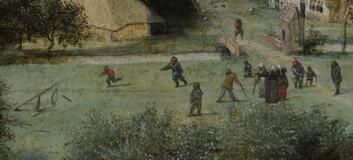 Cock Throwing Cock Throwing
Modifications to this painting: The Metropolitan Museum of Art acquired this painting in 1919. When they cleaned the painting and analyzed it, they noticed that Bruegel modified this painting on the canvas itself. Under the painting, an initial drawing of Bruegel was discovered, before he started painting it. Bruegel made several changes to this painting while painting it. For example, the right hand of the sleeping man next to the tree was in an awkward position, and Bruegel decided later to add a cap to this man that was slipping from his head to cover up this hand. If you look carefully, you can still see the bottom of his right arm through the cap.
Another example is that he first painted the church and later decided to add a branch to the pear tree to cover part of the church tower. You can see the rest of the church tower under the branch. The reason that you can see these modifications is that Bruegel used only a thin layer of paint that became somewhat transparent over time. What is humanism? Pieter Bruegel the Elder was one of the early painters that abandoned the religious or classical themes in his paintings and focused instead on the people. This focus on people was in line with the humanist movement in society. Bruegel seemed to have been well-educated and had many humanist friends. Humanism puts the human being central and focuses on the values and behaviors of people. The impact of humanism on art was a focus on realistic depictions of people and their environments. This realism can clearly be observed in the works of Bruegel. Who is Bruegel the Elder? Pieter Bruegel the Elder was born between 1525 and 1530 in Breda in The Netherlands and died in 1569 in Brussels (his name is sometimes spelled as Brueghel). Opposite to the popular High Renaissance style developed in Italy during that time, Bruegel used a more realistic painting style which we now classify as the Northern Renaissance style. Bruegel was a specialist in genre art (scenes from everyday life) and specifically in painting landscapes and depicting peasants. The artistic talent ran in the Bruegel family, and several people in his family tree were accomplished painters as well, including the two sons of Pieter Bruegel the Elder: Jan Brueghel the Elder and Pieter Brueghel the Younger. Fun fact: A group of about ten people in the middle of the paintings is playing a game. This game is identified as cock throwing, which was especially popular in England. On the left, you can see a rooster tied to a branch hanging in the air. The goal of the game was that people would throw sticks at the rooster until it died. The person who killed the rooster could keep it. Cock throwing is a so-called blood sport, a category of games that involved the killing or injuring of animals. These blood sports were quite popular in the 16th century. An even more popular blood sport around that time was cockfighting, a sport that is still practiced in some countries nowadays. Interested in a copy for yourself? Poster or canvas.
The painting shows a large ripe gold-colored wheat field which is ready for harvest. On the right are two darker cypresses that draw the attention. To the left are lighter and smaller cypresses. The whirling clouds and blue mountains in the background complete this landscape. You can almost feel the wind that is affecting the clouds and the wheat field. This movement is emphasized by the impasto technique used for this painting, in which the paint is applied in thick layers.
Backstory: Van Gogh painted this wheat field (by some referred to as a cornfield) with cypresses when he was in a mental asylum in Saint Remy in the south of France. He painted this when he was allowed to make short walks and paint outside of the asylum. He was particularly impressed by the cypresses he saw there as he felt that this tree reflected some of his emotions. Van Gogh liked this painting so much that he repeated this painting three more times. One version is in the National Gallery in London (and was acquired in 1923 for ₤300, which was similar to the price of a house at that time). Another (smaller) version is part of a private collection. The last version (a pen drawing) is in the Van Gogh Museum in Amsterdam.
Symbolism: Van Gogh used his paintings to express his ideas of the meaning of life. The wheat fields represent the cycle of life, where people celebrate their growth, but at the same time are susceptible to the powerful forces of nature. The cypresses are a symbol of stability in a wild landscape (though at the same time the cypress was associated with cemeteries and death in the south of France, though many believe that this was not the intended meaning of the cypresses for Van Gogh).
Who is Vincent van Gogh? Vincent van Gogh (1853 – 1890) was born in The Netherlands. His work is classified as Post-Impressionism and includes landscapes, portraits, self-portraits, and still lifes. Well-known are his depictions of cypresses, sunflowers, and wheat fields. In 1886, Van Gogh moved to Paris, where he connected with the French Impressionists, such as Paul Gauguin and Claude Monet. In 1888, Van Gogh moved further south in France to Arles where he painted his famous series of sunflower paintings, including the version that is in the National Gallery in London. A year later he moved to a nearby mental asylum in Saint Remy, due to his poor mental state, but continued to produce his paintings. During this time, he produced not only this painting but also The Starry Night which is in the Modern Museum of Art in New York. Van Gogh was a heavy drinker and smoker, and his mental state is often reflected in his paintings. In 1890, Van Gogh died at 37 years old from a self-inflicted gunshot wound.
What is post-impressionism? Post-Impressionism is a French art movement which developed in response to Impressionism. It is an extension of Impressionism, which is characterized by paintings with bright colors, real-life subject matters, and a thick application of paint.
Post-impressionism extended on Impressionism by adding emotions and symbolism to the paintings to reflect the artist’s state of mind. Besides Van Gogh, well-known painters in this movement include Paul Gauguin, Georges Seurat, and Paul Cézanne. Fun fact: On the list of the 100 most expensive paintings ever sold, Pablo Picasso, Andy Warhol, and Vincent van Gogh are best represented. Van Gogh has most paintings on this list (at least seven). For example, Wheat Field with Cypresses was bought in 1993 for $57 million and donated to the Metropolitan Museum of Art. But unlike Picasso and Warhol, Van Gogh did not get rich during his life. In fact, the only known painting that Van Gogh sold during his life, The Red Vineyard, was sold for 400 Belgian Francs, which is worth about $1,500 nowadays. Interested in a copy for yourself? Poster or canvas (Amazon links)
What do you see? This marble statue shows the Greek demigod Perseus holding the head of Medusa. Perseus is standing in a triumphant pose as he has just beheaded Medusa. He holds the head of Medusa in his left hand by grabbing the venomous snakes on her head. The face of Medusa expresses horror as it has just been cut off. However, you can also still see the beauty of her face.
Interestingly, Perseus is looking at her face, even though that should turn him into stone according to the myth (but the irony may be that this actually happened in this statue). Perseus is wearing the sandals of the Roman messenger god Mercury (Hermes in Greek) which allowed Perseus to fly. These sandals were made of gold by the god Vulcan (Hephaestus in Greek). Perseus also wears the cap of Hades, which could make him invisible. In his right hand, Perseus is holding a harpe sword, which is a sword with a sickle-like extension on one side of the blade. The sword was owned by Zeus, the father of Perseus. A robe hangs loosely over his arm. Notice that his left foot is standing in the front, while the heel of his right foot is lifted. In this way, Canova creates the sense that Perseus is moving forward.
Backstory: Antonio Canova made this statue twice. The first version is on display in the Vatican Museums and is also known as Perseus Triumphant. A replica by Canova is in the Metropolitan Museum of Art. The head of Medusa in this statue has been inspired by the Medusa Rondanini, a marble sculpture that is in the Glyptothek in Munich.
The rest of the statue has been heavily inspired by the Apollo Belvedere, a famous statue from antiquity, which is also in the Octagonal Court of the Vatican Museums. The first version of the statue of Perseus and Medusa was acquired by Pope Pius VII to replace the Apollo Belvedere which Napoleon Bonaparte had confiscated and shipped to the Louvre in Paris. When the Apollo Belvedere returned to Rome, they kept the statue of Canova as it was such a great piece of work. When the second version of this statue first arrived at the Metropolitan Museum of Art, the sword was missing. They took a cast from the version in the Vatican Museums and added a newly carved marble sword to the statue.
The story of Perseus and Medusa: In Greek mythology, Perseus is the son of Jupiter (Zeus in Greek), who was the king of the gods, and Danaë. Polydectes, the King of Seriphos, ordered Perseus to provide him with the head of Medusa as a wedding gift for him.
Medusa was one of three sisters (Stheno, Euryale, and Medusa) who were often referred to as Gorgons. Both Stheno and Euryale were immortal, but Medusa was not. According to the Roman poet Ovid, Medusa was a beautiful young woman. However, after Poseidon (the god of the sea) made love to her in Athena’s temple, Athena (the goddess of wisdom and war) changed her beautiful locks into living, venomous snakes (in other mythological stories the three sisters were already born with snakes on their heads). Medusa had a horrific facial expression that could turn people (or according to some, only men) who looked at her into stone. Perseus used a shiny shield that he got from Athena to avoid looking at Medusa directly and succeeded to cut off her head. When Perseus returned to King Polydectes, he showed him the head of Medusa, which still retained its power, which turned Polydectes into stone. This was the purpose of Perseus as he discovered that Polydectes had abused his mother. Perseus and Medusa in art? Perseus and Medusa have been a popular subject in art. Famous artists have used their story as the inspiration for their artwork. Leonardo da Vinci created two version of the head of Medusa, but neither of them has survived. Caravaggio has painted the head of Medusa on a shield which is in the Uffizi Museum. Rubens also created two versions of the Head of Medusa, of which one is in the Kunsthistorisches Museum in Vienna. Various sculptures of Perseus and Medusa have also been made, such as one by Benvenuto Cellini.
What is neoclassicism? Around 1760, neoclassicism started in Rome in opposition to the then-popular Baroque and Rococo styles. The neoclassic style quickly spread through Europe and become especially popular in France, with artists such as Jacques-Louis David and Jean-Auguste-Dominique Ingres.
Neoclassic art is inspired by the old Roman and Greek art and focuses on simplicity and symmetry. The paintings, sculptures, and architecture in this style did not show much emotion, were more ordered and down-to-earth compared to the Baroque style and were less playful compared to the Rococo style. Fun fact: When making a statue of marble, the artist needs to be aware of the center of gravity. In this sculpture, the stretched arm of Perseus and the head of Medusa naturally shift the center of gravity. Canova included two tricks to keep the sculpture stable and decrease the chances that it gets severely damaged by movement or that the head would simply break off.
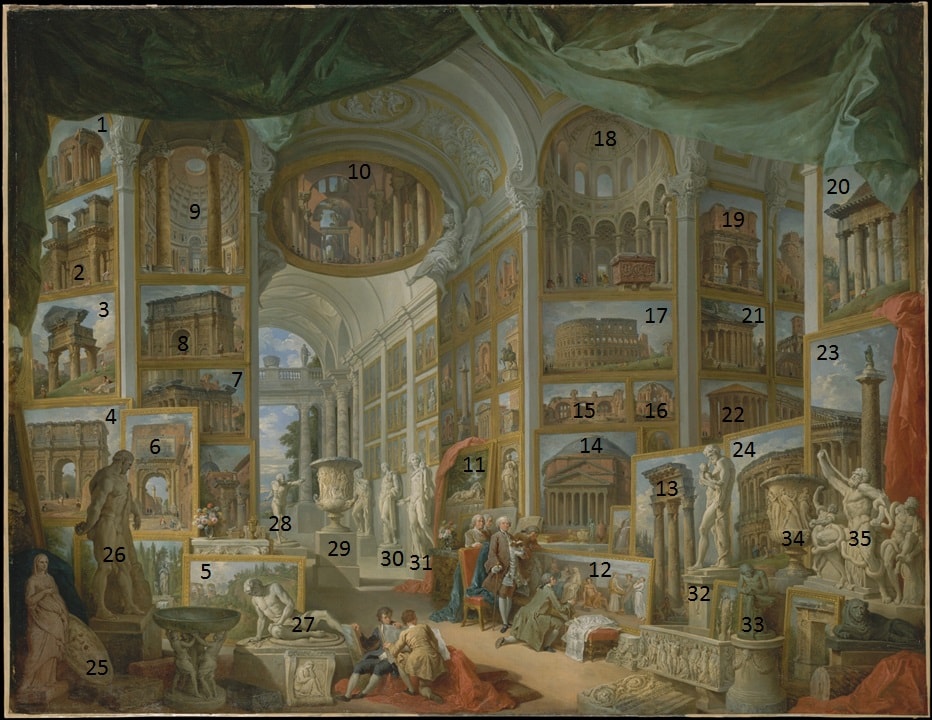 Annotated Ancient Rome Annotated Ancient Rome
Where? Room 629 of the Metropolitan Museum of Art
When? 1757 Commissioned by? Count de Stainville What do you see? On top is a green curtain that is pulled aside to show many paintings and sculptures of ancient Roman monuments. Panini and his patron Count de Stainville appear in the painting. Panini is standing directly behind the chair in the middle, while Count de Stainville is standing in front of him with a book in his hand. In the figure below the paintings are numbered to make it easy to understand what they represent.
Backstory: The painting was created together with a painting of Modern Rome, which is in the same room of the Metropolitan Museum of Art. The idea was that the monuments in this painting represent all the works that a young gentleman of a good family should see on his tour of Rome. This kind of tours was popular among the rich to educate young men about the cultural world.
There are three versions of the Ancient Rome painting and they all look slightly different. Besides the version in the Metropolitan Museum of Art, the Staatsgalerie in Stuttgart has on version, and the Louvre has another version. Why Rome? Rome was the capital of the Roman Empire. It is considered to be the birthplace of the Western civilization. It contains a large number of ruins, monuments, buildings, museums, etc., of significant historical importance. Since the beginning of the Renaissance, it has attracted many well-known artists and contributed to their development. Who is Panini? Giovanni Paolo Panini (1691-1765) was an architect, painter, and professor. He is known as a vedutisti, which is a painter of a veduta (Italian for ‘view’). A veduta is a highly detailed painting of a certain view, such as a city or landscape. While born in Piacenza, he spent most of his life in Rome, which has been the dominant theme in his paintings. Fun fact: Panini painted multiple versions of this painting within three years. The painting is part of a set of three other paintings, a painting of Modern Rome, a painting of Saint Peter’s Square, and a painting of the interior of Saint Peter’s. Because of the popularity of these paintings, he created this set of four paintings twice (remember that there were no photographs possible in his time, so this was probably the best you could get as a picture of Rome). He also created a third and fourth version of Ancient Rome and Modern Rome. Interested in a copy for yourself? Poster or canvas.
Where? Room 629 of the Metropolitan Museum of Art and Gallery 246 of the Museum of Fine Arts
When? 1757 Commissioned by? Count de Stainville What do you see? A large number of paintings of buildings, fountains, and monuments in Rome around 1757. The commissioner of this painting, Count de Stainville, who was the French ambassador to the Vatican in Rome between 1753 and 1757, is sitting in an armchair in the foreground. In the painting below the paintings and sculptures are numbered to make it easy to understand what they represent.
Backstory: Panini created a total of three versions of this painting. He created two similar versions for Count the Stainville. The original version is at the Museum of Fine Arts in Boston, and a copy of that version is at the Metropolitan Museum of Art. Two years later, he created a somewhat different version of this painting for Claude-François de Montboissier de Canillac de Beaufort. This version is now in the Louvre in Paris.
The Modern Rome painting in the Metropolitan Museum of Art hangs next to another work of Panini, Ancient Rome, which shows monuments and art from ancient Rome.
What is a veduta? Panini is known for painting views of Rome. These views are called veduta (plural vedute), which is a type of painting that accurately provides a view of a city or another vista. This style initiated in Belgium and The Netherlands in the 17th century and became more popular in 18th-century Italy.
There are two main types of vedute. First, the vedute prese da i luoghi, which are exact representations of a city view or other vista. Second, vedute ideate, which are scenes that also contain some imaginary elements such as buildings or monuments from the past. The current painting by Panini is a good example of the first type of veduta, while his Ancient Rome is a good example of the latter type. As photography did not exist yet, vedute were a great way for rich travelers to bring home their memories. The magnificent vedute by Panini were in high demand in the 18th century, and it is not surprising that painters sometimes created multiple versions of the same veduta painting. Who is Panini? Giovanni Paolo Panini was born in 1691 in Piacenza, Italy, and died in Rome in 1765. He was both an architect and painter and was considered to be the most influential painter in Rome during the 18th century. Early in his career, he mainly painted frescos for the rich people in Rome. From around 1729, he started to focus on painting various views of Rome for which he is best known today. Another example of a veduta painting by Panini is the Interior of the Pantheon of which one version is in the National Gallery of Art, and another version is in the Cleveland Museum of Art. Panini also painted some religious works, but these works have never reached the same amount of fame as his vedute.
Fun fact: At the end of the 16th century, rich people in Europe send their kids on tour through Europe as part of their education. These trips are referred to as Grand Tours. On these trips, kids of about 21 years old typically visited cities such as Paris, Florence, Rome, and Venice. A knowledgeable family member or a professional tutor accompanied them on their tour. For example, the great economist and one of the founders of capitalism, Adam Smith, worked for quite some years as a tutor.
Before the existence of photography, these tours were popular among the rich people in England, Germany, Scandinavia, and the United States. Veduta paintings, such as the ones by Panini, became popular among these people to preserve their memories. |
Categories
All
|
- Home
- Blog
-
Museums
- Alte Pinakothek
- Art Institute of Chicago
- Baltimore Museum of Art
- Barber Institute of Fine Arts
- Bargello
- Barnes Foundation
- British Museum
- Church of Sant’Anastasia
- Cleveland Museum of Art
- Courtauld Institute of Art
- Detroit Institute of Arts
- Frans Hals Museum
- Galleria Borghese
- Gallerie dell'Accademia
- Getty Museum
- Guggenheim
- Hermitage Museum
- Kunsthistorisches Museum
- Kunstmuseum Basel
- Legion of Honor Museum
- Louvre
- Mauritshuis
- Metropolitan Museum of Art
- Musee d’Orsay
- Museum of Fine Arts in Boston
- Museum of Modern Art
- National Gallery in London
- National Gallery of Art
- National Museum in Poznań
- Norton Simon Museum
- Ny Carlsberg Glyptotek
- Palace of Versailles
- Palazzo Pitti
- Palazzo Vecchio
- Petit Palais
- Philadelphia Museum of Art
- Prado
- Pushkin Museum
- Ravenna Art Museum
- Rijksmuseum
- San Diego Museum of Art
- Santa Maria delle Grazie
- St. Peter's Basilica
- Städel Museum
- Statens Museum for Kunst
- Tate Britain
- Tate Modern
- Timken Museum of Art
- Uffizi
- Vatican Museums
- Wallace Collection
-
Artists
- Altdorfer
- Anguissola
- Berlin Painter
- Bosch
- Botticelli
- Boucher
- Bronzino
- Bruegel the Elder
- Brunelleschi
- Cabanel
- Caillebotte
- Canova
- Caravaggio
- Carpeaux
- Cezanne
- Cimabue
- David
- Degas
- Delacroix
- De Maria
- Donatello
- El Greco
- Fontana
- Fra Angelico
- Fragonard
- Gauguin
- Gentileschi
- Gericault
- Gonzalez-Torres
- Goya
- Hals
- Hogarth
- Hokusai
- Ingres
- Leonardo da Vinci
- Lippi, Filippo
- Longhi, Barbara
- Lorrain
- Makovsky
- Manet
- Massys
- Matisse
- Merian
- Michelangelo
- Mochi
- Modigliani
- Monet
- Panini
- Parmigianino
- Perugino
- Picasso
- Pisanello
- Raphael
- Rembrandt
- Renoir
- Reynolds
- Rivera
- Rodin
- Rubens
- Scultori
- Seurat
- Steen
- Tintoretto
- Titian
- Toulouse-Lautrec
- Turner
- Uccello
- Van der Weyden
- Van Dyck
- Van Eyck
- Van Gogh
- Van Hemessen
- Vasari
- Velazquez
- Vermeer
- Veronese
- Vigée Le Brun
-
Locations
- Books
- About Us

